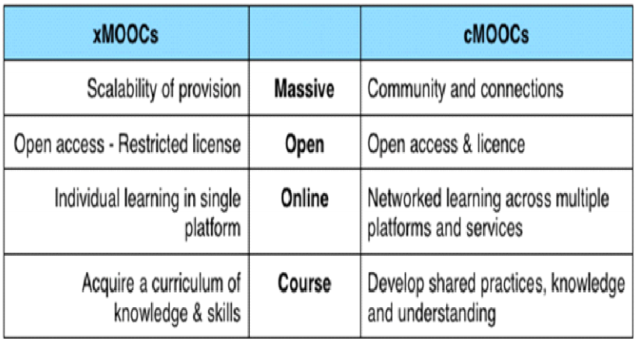What are the differences between MOOC and LMS?
- Massive Open Online Course (MOOC) Definition
Massive Open Online Course (MOOC) is a free Web-based distance learning program that is designed for the participation of large numbers of geographically dispersed students. MOOC may be patterned on a college or university course or may be less structured. Although MOOCs don’t always offer academic credits, they provide education that may enable certification, employment or further studies (Rouse, 2013).
The concept of a MOOC was first introduced by Stephen Downes and George Siemens in 2008 as they were building a course offered by the University of Manitoba. The course’s name was Connectivist and Connective Knowledge (Beijing Normal University, 2011). This course was the first course to be labeled a MOOC because there were 25 tuition-paying students from university and 2,300 non-paying students from the general public who took the course online (Rouse, 2013).
There are two main models of MOOC (Ping, 2013):
- cMOOC, which is based on the connectivist learning theory.
cMOOC focuses on knowledge construction and creation. This platform puts much emphasis on creation, autonomy, and social network learning. Participants in the course act as both teachers and students, sharing information and engaging in a joint teaching and learning experience through intense interaction facilitated by technology. A typical design of a cMOOC assumes collaboration between course participants using various social media (e.g., blogs, Twitter, Facebook, Google+, RSS feeds and mailing lists).
- xMOOC, which is based on the behaviorism learning theory.
xMOOC is closer to traditional teaching process and concept, focusing on knowledge dissemination and duplication, as well as such learning methods of video, homework and test. A further division of xMOOC into two models can be identified: profit and non-profit to serve different purposes
Table Comparison xMOOC vs cMOOC
Source: (Agrawal, et al., 2015, p. 392)
- Learning Management Systems (LMS) Definition
Learning management systems are software systems designed to assist in the management of educational courses for students, especially by helping teachers and learners with course administration. One of the most important features of an LMS is to provide an environment for learning and teaching without the restrictions of time or distance. LMSs helps instructors and learners discuss the course content by posting and responding to each other, maintaining student learning tracks, and managing learning activities in an online environment. Currently, LMSs improve instructor teaching and student performance across various fields of study. A learning management system may also provide students with the ability to use interactive features such as threaded discussions, video conferencing, and discussion forums. The systems can often track the learners’ progress (Chung, et al., 2013).
In addition, five categories of LMS features for higher education are discussed including (Chung, et al., 2013):
- Transmitting course content
The transmitting course content category includes three major features of an LMS: course content, announcements, and the grade book. Although the first two features are valuable, the grade book was unsuitable for complex grading or evaluation systems.
- Evaluating students
The most commonly used LMS tool in the evaluation and assessment category is the test generator, which helps instructors create course assessments and allows students to submit the test via the drop box function. A good test generator should include a flexible approach to create various evaluation methods. The importance of interaction in the evaluation process, which would allow the learner to check and monitor their academic activities and improve student-learning performance.
- Evaluating courses and instructors
In the evaluating course and instructor category, the LMS allows students to evaluate both the course and the instructor at the end of the semester. Course evaluation serves a very important function in education because it helps instructors understand if they need to modify the course content, as well as their teaching approaches to improve the overall learning and teaching experience.
- Creating class discussions
In creating a discussion category, asynchronous discussions had higher approval ratings than synchronous discussions because participants have more time to read and respond to questions. In spite of this difficulty, synchronous discussions have certain benefits that could help participants feel a stronger sense of social interaction. Therefore, designing a feature that creates longer discussion formats should be considered as a viable option to provide users the opportunity to participate in discussions.
- Creating computer-based instruction
The use of computer-based instruction (CBI) is a feature that has been designed to help instructors transmit content for years. Today, several technique tools could effectively and efficiently help instructors to create teaching content, e.g., Prezi, SlideRocket, Flickr, YouTube, Sliceshare, and Knovio. These social media tools could enhance various teaching presentations and course curriculum. Therefore, the LMS should be flexible and offer an adaptable and creative in its CBI to improve the online learning experience.
References:
Rouse, M. (2013, August). Massive Open Online Course (MOOC). (I. Wigmore, Editor) Retrieved September 3, 2016, from WhatIs.com: http://whatis.techtarget.com/definition/massively-open-online-course-MOOC
Beijing Normal University. (2011). 10th World Conference on Mobile and Contextual Learning. October.
Ping, W. (2013). The Latest Development and Application of Massive Open Online Course:From cMOOC to xMOOC. Retrieved September 2, 2016, from http://en.cnki.com.cn/Article_en/CJFDTOTAL-XDYC201303005.htm
Agrawal, P., Kumar, A., & Agrawal, A. (2015, March 12). Massive Open Online Courses: EdX.org, Coursera.Com and NPTEL, A Comparative Study Based on Usage Statistics and Features with Special Reference to India. 10th International CABLIBER 2015, 393-397. Retrieved October 2, 2016, from http://ir.inflibnet.ac.in/bitstream/1944/1879/1/40.pdf
Chung, C.-H., Pasquini, L. A., & Koh, C. E. (2013). Web-based Learning Management System Considerations for Higher Education. Reseach Gate.



